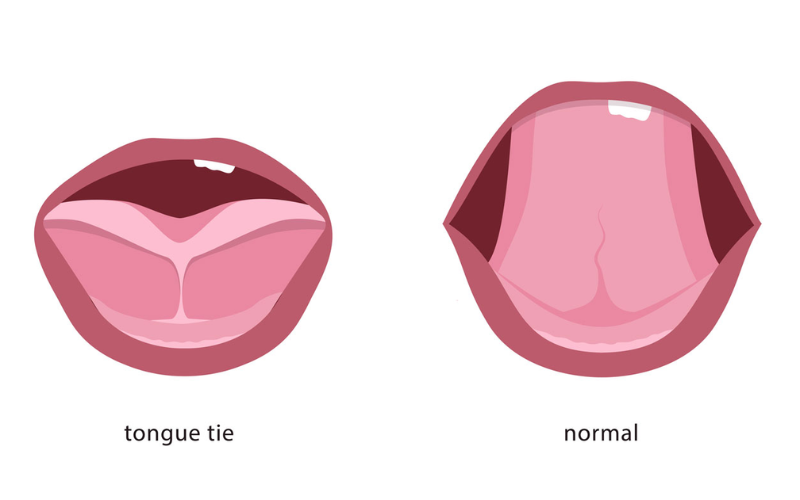Spokane Valley:
(509) 228-3834

Lip And Tongue-Tie 101: What Parents Need To Know About Baby Feeding Challenges
For new parents, feeding time can be both a joyful bonding experience and a stressful challenge, especially when a baby struggles to latch or feed efficiently. While feeding issues are not uncommon, one lesser-known cause could be a lip or tongue-tie.
These conditions can complicate the feeding process for infants, leaving many parents puzzled and worried. In this blog, we’ll walk you through everything you need to know about lip and tongue-ties, how they affect feeding, and what you can do to help your baby feed more comfortably.
What Are Lip and Tongue-Ties?
Lip and tongue-ties occur when a baby’s frenulum, the small piece of tissue that connects the lip or tongue to the mouth, is too short, thick, or tight. This restriction limits the movement of the lip or tongue, which can lead to challenges in breastfeeding, bottle feeding, and even, later on, speech development.
- Lip-Tie: The frenulum under the upper lip is too tight, making it difficult for the baby to latch onto the breast or bottle.
- Tongue-Tie (Ankyloglossia): The tissue under the tongue is too restrictive, impacting the tongue’s movement and ability to reach out fully.
How They Affect Infant Feeding?
When a baby’s lip or tongue cannot move freely, it can lead to feeding complications such as poor latching, excessive sucking effort, or even discomfort for the mother during breastfeeding. Here are some of the common ways lip and tongue-ties impact feeding:
- Difficulty Latching: A restricted lip or tongue can make it difficult for the baby to achieve a deep latch, resulting in inadequate feeding.
- Poor Milk Transfer: If the baby isn’t latched well, they may struggle to extract milk effectively, leading to frequent, prolonged feedings.
- Pain for the Mother: Poor latching often causes sore or cracked nipples for breastfeeding mothers, adding to the stress and discomfort.
- Gassiness and Colic Symptoms: Babies with ties may swallow more air while feeding, which can lead to gassiness, fussiness, and even colic-like symptoms.
Signs & Symptoms of Lip and Tongue-Tie

Recognizing the signs of a lip or tongue-tie early can help you seek prompt assistance so you and your baby have a smoother feeding experience. Here are some symptoms to watch for:
For Babies:
- Difficulty latching onto the breast or bottle.
- Frequent slipping off the nipple during feedings.
- Prolonged feeding sessions.
- Clicking noises while feeding.
- Gassiness or signs of colic.
- Slow weight gain or inadequate weight gain.
For Mothers:
- Persistent nipple pain or soreness.
- Mastitis or clogged milk ducts due to poor drainage.
- Frustration or anxiety around feeding times.
Diagnosing Lip and Tongue-Tie
If you suspect your baby has a lip or tongue-tie, consulting with a healthcare provider is essential. A pediatrician or pediatric dentist is often trained to evaluate these conditions and can provide an accurate diagnosis. Diagnosis typically involves:
- Physical Examination: The provider will examine your baby’s mouth, looking specifically at the frenulum under the tongue and upper lip.
- Assessment of Feeding Patterns: Some providers may observe a feeding session to evaluate latching and milk transfer.
Treatment Options for This Issue
The good news is that treating lip and tongue-ties is relatively easy if they’re causing significant feeding issues. The primary treatment is a simple procedure to release the restricted frenulum, allowing for more mobility. Treatment options include:
- Frenotomy (Snipping): The provider quickly cuts the frenulum to release the restriction, usually using scissors or a laser, and often completes the procedure within seconds.
- Frenuloplasty: Providers typically perform this more extensive procedure if the frenulum is thicker, often using sutures and administering local anesthesia.
Practical Tips To Feed a Baby with Lip or Tongue-Tie
While awaiting a consultation or considering treatment, here are some helpful tips to make feeding easier:
- Experiment with Positions: Sometimes, changing feeding positions (like the football hold for breastfeeding) can help your baby achieve a better latch.
- Use Slow-Flow Bottles: For bottle-feeding, a slow-flow nipple can help control milk flow, making feeding easier for babies struggling with latching.
- Paced Bottle Feeding: Allowing your baby to take breaks and control the pace can help reduce gassiness and frustration.
- Seek Support from a Certified Dentist: Our certified dentist can provide hands-on support and teach techniques to improve latch and reduce discomfort.
Navigating Feeding Challenges with Confidence!
Lip and tongue-ties may seem overwhelming, especially for new parents already navigating the challenges of feeding and bonding with their baby. Understanding what to look for, getting an accurate diagnosis, and exploring treatment options can make a world of difference for both you and your little one.
If you’re struggling with feeding or suspect a lip or tongue tie, don’t hesitate to reach out to our dentist. Our dental practice offers prompt help with the right support, so you and your baby can overcome these early challenges and enjoy a healthy feeding journey.


